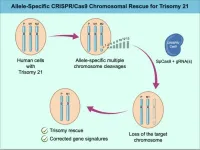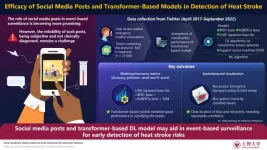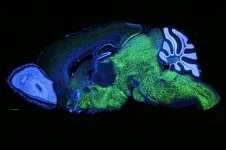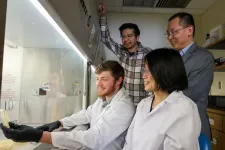(Press-News.org)
New research brings hope for improved outcomes and survival rates for patients facing a pancreatic cancer diagnosis
The discovery of a 'biomarker panel' could have a profound impact on the ability to identify patients at risk of developing PC at an earlier stage
Pancreatic cancer (PC) is the worst prognosis cancer globally, with just 13% of patients who are diagnosed with PC surviving for 5 years or more after initial diagnosis. In Ireland, there are approximately 900 cases of PC per year, and 820 PC-related deaths. Early detection of PC is the primary concern of most PC research, as it has the potential to make a substantial difference to the treatment and survival of patients.
Survival rates, however, remain poor due to the vague nature of the symptoms associated with early-stage PC, and subsequently the late-stage of the disease at diagnosis. Now researchers from the Maher lab group, School of Medicine at Trinity College Dublin are focussing on pancreatic cystic lesions to tackle the crucial issue of identifying patients who are at high-risk of developing pancreatic cancer, to improve survival rates [Wednesday, 12th February 2025].
Their study was recently published in the peer-reviewed journal Scientific Reports.
Pancreatic cystic lesions are fluid-filled sacs that can be found on or inside the pancreas. There are many different types of pancreatic cystic lesions, with some being benign and others having the potential to develop into PC. Unfortunately, our ability to identify the pancreatic cystic lesions most likely to progress to PC, and therefore termed ‘high-risk,’ is quite poor.
Research from the Maher lab has identified a number of factors within the patients’ blood and the fluid in their pancreatic cystic lesions, which can be found at different levels in patients who are at a low-risk or a high-risk of PC development. These factors, or ‘biomarkers,’ have been combined in this study to create a unique biomarker panel that shows high accuracy in its ability to distinguish between low-risk and high-risk patients. At present, there are several sets of clinical guidelines worldwide used to separate patients into risk groups based on their clinical presentation and symptoms. However, the existence of several sets of guidelines worldwide indicates the lack of agreement among clinicians as to the best way to separate patients into risk groups. As such, our ability to distinguish low-risk and high-risk patients is imperfect and could therefore be contributing to the overall problem of early detection.
The results reported in this study not only describe the deregulation of proteins and genetic material in pancreatic disease, but also demonstrate their potential utility as biomarkers of patient PC risk. While these data remain to be validated in a larger, independent cohort, the Maher lab group biomarker panel could have a profound impact on our ability to identify patients at risk of developing PC at an earlier stage.
The group’s work generated four large datasets that are now publicly available for download and use. Together, these datasets can be combined into a larger and unique dataset that has been unavailable online until now and can be used for a myriad of research purposes, such as the development of new treatments for PC patients, or the identification of key biological pathways involved in pancreatic cystic lesion development or progression to PC.
The research has been spearheaded by Dr Laura Kane, Research Ireland Postdoctoral Research Fellow, Professor Barbara Ryan, Consultant Gastroenterologist, and Professor Stephen Maher, Professor in Translational Oncology.
Dr Laura Kane, Senior Author and Maher lab group member said:
"Improving outcomes and survival rates for patients facing a pancreatic cancer diagnosis is our research priority. In this study we have created a promising biomarker panel with the potential to help us identify individuals with a high risk of developing pancreatic cancer. Our hope is that with further development, this biomarker panel will enable us to effectively monitor high-risk patients, detect pancreatic cancer at an earlier stage, and therefore improve outcomes and survival rates for these patients."
Professor Stephen Maher, research group lead said:
“This research aims to better understand the biology of pancreatic cysts and how they contribute to the development of pancreatic cancer. Our work also aspires to develop a much less invasive procedure to monitor these patients, making surveillance easier for both patients and clinicians.”
Dr Laura Kane has recently been awarded a 2-year Research Ireland Postdoctoral Research Fellowship to continue this work under the mentorship of Professor Maher.
READ: You can read the full paper, Multi-omic biomarker panel in pancreatic cyst fluid and serum predicts patients at a high risk of pancreatic cancer development at the following link: https://www.nature.com/articles/s41598-024-83742-4
Ends/
Ciara O’Shea
Research Communications Manager (Health Sciences)
Trinity Communications
Trinity College Dublin
086 787 0746 | coshea9@tcd.ie
END
Gene editing techniques may eventually allow trisomy to be treated at the cellular level, according to an in vitro proof-of-concept study. Down syndrome is caused by the presence of a third copy of the 21st chromosome. The condition occurs in approximately 1 in 700 live births and is relatively easy to diagnose at early stages of development. However, there are no treatments. Ryotaro Hashizume and colleagues use the CRISPR-Cas9 gene editing system to cleave the third chromosome in previously generated trisomy 21 cell lines derived from both pluripotent cells and skin fibroblasts. The technique is able to identify which chromosome has been duplicated, ...
Heat stroke poses a significant health risk, especially during extreme temperature conditions. As global temperatures rise due to climate change, the frequency and severity of heatwaves have increased, putting vulnerable populations at greater risk. This shift underscores the need for effective, real-time methods for early detection and response to heat stroke risks, ensuring timely intervention and reduced impact of these rising threats. While previous studies have highlighted the potential of social media posts, such as tweets, to offer real-time insights into various events, its application in detecting heat stroke risks ...
ARLINGTON, Va. (Feb. 18 2025) – A new study led by Conservation International scientists and published today has found that grassland restoration can reduce human-wildlife conflict and social conflicts in communities facing resource scarcity.
Grasslands, vital ecosystems for livelihoods and biodiversity, are under increasing pressure from climate change and human activity. The Chyulu Hills region of Kenya exemplifies these challenges, as it is home to iconic wildlife such as African elephants and black rhinos, which share the land with pastoral Maasai communities. This coexistence often leads to competition over limited water, land and pasture, sparking ...
Some people wake up vividly recalling their dreams from the night, and can tell precise stories experienced during the night, while others struggle to remember even a single detail. Why does this happen? A new study, conducted by researchers at the IMT School for Advanced Studies Lucca, and published on Communications Psychology explores the factors that influence so called "dream recall"— the ability to remember dreams upon awakening—and uncovers which individual traits and sleep patterns shape this phenomenon.
The reason why there is such a difference in recalling dreams remains a mystery. Some studies found that women, young persons, ...
The immune systems of cancer patients are highly disrupted, with those who have a higher number of immune cells in their blood having a better survival rate, finds a new study that uses a pioneering technique developed by researchers at UCL and the Francis Crick Institute.
The tool, described in Nature Genetics, is called Immune Lymphocyte Estimation from Nucleotide Sequencing (ImmuneLENS). It enables researchers to calculate the proportion of T cells and B cells (types of immune cell) from whole genome sequencing (WGS) data for the first time.
Whole genome sequencing (WGS) uses a blood sample to create a complete ...
*** Embargoed for release until Tuesday, Feb. 18, 2025, at 5 a.m. EST ***
A newly identified part of a brain circuit mixes sensory information, memories, and emotions to tell whether things are familiar or new, and important or just “background noise.”
Led by researchers from NYU Langone Health, the work found that a circuit known to carry messages from a brain region that processes sensory information, the entorhinal cortex (EC), to the memory processing center in the hippocampus (HC) has a previously unrecognized pathway that carries messages directly back to the EC.
Publishing online Feb. 18 in Nature Neuroscience, the study results show that this direct feedback ...
The origins of human language remain mysterious. Are we the only animals truly capable of complex speech? Are Homo sapiens the only hominids who could give detailed directions to a far-off freshwater source or describe the nuanced purples and reds of a dramatic sunset?
Close relatives of ours such as the Neanderthals likely had anatomical features in the throat and ears that could have enabled the speaking and hearing of spoken language, and they share with us a variant of a gene linked to the ability to speak. And yet it is only in modern humans that we find expanded brain regions that are critical for language production and comprehension.
Now researchers from The Rockefeller University ...
SEATTLE – Scientists have developed a breakthrough method to track diet using stool metagenomic data.
Developed by researchers at the Institute for Systems Biology (ISB), the new method, called MEDI (Metagenomic Estimation of Dietary Intake), detects food-derived DNA in stool samples to estimate dietary intake. MEDI leverages stool metagenomics, which refers to sequencing all the DNA present in fecal samples (including microbial, human, and food-derived DNA). This non-invasive, data-driven approach offers an objective alternative to traditional food diaries and questionnaires, ...
Hundreds of different species of microbes live, laugh, and love in your gut. In the future, one of these might serve a new function: microscopic in-house pharmacist.
A new study published Feb. 18 in Nature Biotechnology shows how gut bacteria can be directed to produce and release proteins within the lower gastrointestinal tract — eliminating a major roadblock to delivering drugs to that part of the body.
Oral medication is the most common and practical means of drug administration, but the stomach doesn’t let much pass through unscathed. This is good when it comes to things like foodborne ...
The effectiveness of a common drug to quit smoking could be down to people’s genes, according to a study from the University of Leicester (United Kingdom).
Varenicline is widely recognised as the most effective medication for helping people stop smoking, but unfortunately it does not work for everyone.
Researchers from Leicester have uncovered important insights into how people’s DNA affects their response to the drug, which will soon be available to smokers through the UK’s National Health Service (NHS).
Varenicline ...



